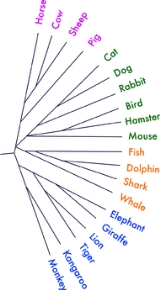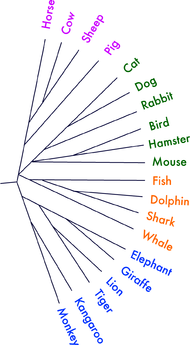
Verbal fluency test
Encyclopedia
Verbal fluency tests are a kind of psychological test
in which participants have to say as many words as possible from a category in a given time (usually 60 seconds). This category can be semantic
, such as animals or fruits, or phonemic, such as words that begin with letter p.
The semantic fluency test is sometimes described as the category fluency test or simply as 'freelisting'. The COWAT (Controlled oral word association test) is the most employed phonetic variant. Although the most common performance measure is the total number of words, other analyses such as number of repetitions, number and length of clusters of words from the same semantic or phonetic subcategory, or number of switches to other categories can be carried out.
areas used in this task, neuropsychological investigations implicate both frontal
and temporal
lobe areas, the contribution of the former being more important in the phonetic variant and of the latter in the semantic variant. Accordingly different neurological pathologies
affecting these areas produce impairments (typically a reduction in the number of items generated) in one or both versions of the task. For this reason fluency tests are commonly included in clinical batteries
, they have also been widely used in cognitive psychological
and neuropsychological
investigations.
 Priming
Priming
studies indicate that when a word or concept is activated in memory, and then spoken, it will activate other words or concepts which are associatively related or semantically similar to it. This evidence suggests that the order in which words are produced in the fluency task will provide an indirect measure of semantic distance
between the items generated. Data from this semantic version of the task have therefore been the subject of many studies aimed at uncovering the structure of semantic memory
, determining how this structure changes during normal development
, or becomes disorganized through neurological disease or mental illness.
These studies generally make use of multiple fluency lists in order to make estimates of the semantic distance between pairs of concepts. Techniques such as multidimensional scaling
and hierarchical clustering
can then be used to visualize the semantic organization of the conceptual space. Such studies have generally found that semantic memory, at least as reflected by this test, has a schematic
, or script-based, organization.
whose core aspects may remain stable throughout life.
For instance, the figure on the right shows a hierarchical clustering analysis of animal semantic fluency data from 55 British schoolchildren aged 7–8. The analysis reveals that children have schematic organization for this category according to which animals are grouped by where they are most commonly seen (on the farm, at home, in the ocean, at the zoo). Children, adults, and even zoology PhD candidates, all show this same tendency to cluster animals according to the environmental context in which they are observed.
It has been proposed that the semantic memory organization, underlying performance in the semantic fluency test, becomes disordered as the result of some forms of neuropsychological disorder such as Alzheimer’s disease
and schizophrenia
, however, the evidence for this has been queried on theoretical and methodological grounds.
Psychological testing
Psychological testing is a field characterized by the use of samples of behavior in order to assess psychological construct, such as cognitive and emotional functioning, about a given individual. The technical term for the science behind psychological testing is psychometrics...
in which participants have to say as many words as possible from a category in a given time (usually 60 seconds). This category can be semantic
Semantics
Semantics is the study of meaning. It focuses on the relation between signifiers, such as words, phrases, signs and symbols, and what they stand for, their denotata....
, such as animals or fruits, or phonemic, such as words that begin with letter p.
The semantic fluency test is sometimes described as the category fluency test or simply as 'freelisting'. The COWAT (Controlled oral word association test) is the most employed phonetic variant. Although the most common performance measure is the total number of words, other analyses such as number of repetitions, number and length of clusters of words from the same semantic or phonetic subcategory, or number of switches to other categories can be carried out.
Performance characteristics
Performance in verbal fluency tests show a number of consistent characteristics in both children and adults:- There is an hyperbolicHyperbolicHyperbolic refers to something related to or in shape of hyperbola , or to something employing the literary device of hyperbole .The following topics are based on the hyperbola etymology:...
decline in the rate of production of new items over the duration of the task. - More typical category examplars are produced with higher frequency (i.e. by more subjects), and earlier in lists, than less typical ones.
- Items are produced in bursts of semantically-related words in the case of the semantic version and phonetic in the case of phonetic version.
Neural correlates
Regarding the brainBrain
The brain is the center of the nervous system in all vertebrate and most invertebrate animals—only a few primitive invertebrates such as sponges, jellyfish, sea squirts and starfishes do not have one. It is located in the head, usually close to primary sensory apparatus such as vision, hearing,...
areas used in this task, neuropsychological investigations implicate both frontal
Frontal lobe
The frontal lobe is an area in the brain of humans and other mammals, located at the front of each cerebral hemisphere and positioned anterior to the parietal lobe and superior and anterior to the temporal lobes...
and temporal
Temporal lobe
The temporal lobe is a region of the cerebral cortex that is located beneath the Sylvian fissure on both cerebral hemispheres of the mammalian brain....
lobe areas, the contribution of the former being more important in the phonetic variant and of the latter in the semantic variant. Accordingly different neurological pathologies
Neurology
Neurology is a medical specialty dealing with disorders of the nervous system. Specifically, it deals with the diagnosis and treatment of all categories of disease involving the central, peripheral, and autonomic nervous systems, including their coverings, blood vessels, and all effector tissue,...
affecting these areas produce impairments (typically a reduction in the number of items generated) in one or both versions of the task. For this reason fluency tests are commonly included in clinical batteries
Clinical neuropsychology
Clinical neuropsychology is a sub-field of psychology concerned with the cognitive function of individuals with neurological and psychiatric disorders. Neuropsychological assessment examines cognitive function in the broadest sense, including the behavioural, emotional, social and functional status...
, they have also been widely used in cognitive psychological
Cognitive psychology
Cognitive psychology is a subdiscipline of psychology exploring internal mental processes.It is the study of how people perceive, remember, think, speak, and solve problems.Cognitive psychology differs from previous psychological approaches in two key ways....
and neuropsychological
Neuropsychology
Neuropsychology studies the structure and function of the brain related to specific psychological processes and behaviors. The term neuropsychology has been applied to lesion studies in humans and animals. It has also been applied to efforts to record electrical activity from individual cells in...
investigations.
Exploration of semantic memory

Priming
Priming may refer to:* Priming , a process in which the processing of a target stimulus is aided or altered by the presentation of a previously presented stimulus....
studies indicate that when a word or concept is activated in memory, and then spoken, it will activate other words or concepts which are associatively related or semantically similar to it. This evidence suggests that the order in which words are produced in the fluency task will provide an indirect measure of semantic distance
Semantic similarity
Semantic similarity or semantic relatedness is a concept whereby a set of documents or terms within term lists are assigned a metric based on the likeness of their meaning / semantic content....
between the items generated. Data from this semantic version of the task have therefore been the subject of many studies aimed at uncovering the structure of semantic memory
Semantic memory
Semantic memory refers to the memory of meanings, understandings, and other concept-based knowledge unrelated to specific experiences. The conscious recollection of factual information and general knowledge about the world is generally thought to be independent of context and personal relevance...
, determining how this structure changes during normal development
Child development
Child development stages describe theoretical milestones of child development. Many stage models of development have been proposed, used as working concepts and in some cases asserted as nativist theories....
, or becomes disorganized through neurological disease or mental illness.
These studies generally make use of multiple fluency lists in order to make estimates of the semantic distance between pairs of concepts. Techniques such as multidimensional scaling
Multidimensional scaling
Multidimensional scaling is a set of related statistical techniques often used in information visualization for exploring similarities or dissimilarities in data. MDS is a special case of ordination. An MDS algorithm starts with a matrix of item–item similarities, then assigns a location to each...
and hierarchical clustering
Hierarchical clustering
In statistics, hierarchical clustering is a method of cluster analysis which seeks to build a hierarchy of clusters. Strategies for hierarchical clustering generally fall into two types:...
can then be used to visualize the semantic organization of the conceptual space. Such studies have generally found that semantic memory, at least as reflected by this test, has a schematic
Schema (psychology)
A schema , in psychology and cognitive science, describes any of several concepts including:* An organized pattern of thought or behavior.* A structured cluster of pre-conceived ideas....
, or script-based, organization.
whose core aspects may remain stable throughout life.
For instance, the figure on the right shows a hierarchical clustering analysis of animal semantic fluency data from 55 British schoolchildren aged 7–8. The analysis reveals that children have schematic organization for this category according to which animals are grouped by where they are most commonly seen (on the farm, at home, in the ocean, at the zoo). Children, adults, and even zoology PhD candidates, all show this same tendency to cluster animals according to the environmental context in which they are observed.
It has been proposed that the semantic memory organization, underlying performance in the semantic fluency test, becomes disordered as the result of some forms of neuropsychological disorder such as Alzheimer’s disease
and schizophrenia
Schizophrenia
Schizophrenia is a mental disorder characterized by a disintegration of thought processes and of emotional responsiveness. It most commonly manifests itself as auditory hallucinations, paranoid or bizarre delusions, or disorganized speech and thinking, and it is accompanied by significant social...
, however, the evidence for this has been queried on theoretical and methodological grounds.
External links
- Word Associations Network - Creates set of associations for user suggested words

